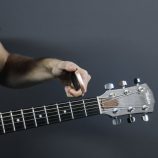Keeping the acoustic guitar in perfect condition is a very important thing.
It’s good for the guitar and the player.
One thing that always gets overlooked is how humidity can influence the shape of your guitar.
If you are interested in keeping your instrument in top shape, I advise you to pay attention to the humidity of the wooden part of the acoustic guitar.
In fact, the lack of moisture is the number one cause of damage to guitars.
Since damage from this kind of type can be permanent, now is the right time to actually do something to ensure the health of your acoustic guitar.
Why humidity is important for guitar owners
Maintaining humidity and temperature in your home or studio where you keep your acoustic guitar is one of the most valuable things you can do for the protection of your guitar.
Improper regulation of air humidity causes one of the most severe damages to the guitar.
Most guitar players do not know exactly what the cause is, and the most common solution is to take the guitar for a repair.
Problems occur often when the temperature is very low or very high. When the temperature is low, the air is dry. The dry air in acoustic guitars causes the top of the guitar to shrink in.
With this, the guitar action is low and it makes the guitar harder to play.
The worst scenario of dry air is when the bridge is pealing from the body of the guitar. Surely this is something you’ve met many times. In addition, cracks on the guitar finish are most commonly seen, and this definitely doesn’t look good.
Now, what happens when the air is too humid?
Moisture can widen the wood and the body of the guitar.
With this the guitar action is high and it produces a dull sound.
Also, when the air is too humid, there is an emergence of mold on the metal parts of the guitar, which can be the worst.
Therefore measuring and maintaining the humidity of the air is very important for the well being of your guitar.
How to measure humidity
Measuring the air humidity is the first step in protecting your guitar.
The ideal level of air humidity is between 40% and 60%.
Somewhere these numbers are more constrained, for example, 45% to 55%.
But I do not think there is a need to be too strict considering that until now you haven’t even paid attention to the humidity at all.
There are several manufacturers of accessories for guitars that have gadgets to measure the humidity of the air.
Taylor Hygro Thermometer Mini
This hydro thermometer is recognizable by its size.
Its dimensions are adapted to any environment where guitars can be stored, such as the daily stay, the studio and even the guitar case.
This will keep you informed about the conditions under which your guitar is stored.
Through a mobile application, it can inform you if the level required for keeping the guitar is above or below the limit.
It’s a proper thermometer, so you can expect that it will constantly report on the temperature of the air where your guitar is stored.
The vibration detection option also informs you of any stroke or drop of the guitar.
Now that we know the magnitude of the problem, its consequences, and how to measure humidity and temperature, the question that remains is – which humidifier is the best and most effective?
Types of humidifier
Protection from harmful levels of moisture to the guitar can come in several shapes and sizes.
- The most common form of humidifier is in an item that is placed directly in the guitar suitcase.
- It is a plastic or rubber piece with small holes on the surface, inside there is a wet sponge that releases moisture inside the guitar. By placing the moisturizer in the actual guitar case, the moisture is kept inside.
- There are also models where the humidifier is placed completely in, so far that it can be attached to the guitar strings. The best place to attach it is between the middle two wires.
The second part is placed around the headstock. Combining these two pieces balances the humidity of the entire guitar. - But if you happen to have more guitars, then this type of humidifier can be very complicated because it should be placed in a separate case for each guitar. In this case, the best solution is a humidifier that keeps the humidity at a level for all the guitars.
- Another type of humidifier is in the form of a plastic tent in which the guitar is placed. It has a system that regulates humidity itself within the normal range (between 40% and 50%) so the whole guitar is exposed and equally affected. This is perhaps the most effective way to keep the guitar from dry or wet air.
- And there is even another option where the humidifier is actually in the shape of a guitar sound hole. This humidifier covers the entire hole with its shape. Unlike other humidifiers, this completely closes the hole so that all moisture remains in the inner part of the guitar.
What are the best humidifiers?
Musik Tent Guitar Humidor Humidifier
This is the best way to avoid putting stuff in the guitar sound hole. It does not need extra maintenance items such as batteries and sponges, and there’s no need for constantly refilling water to the system.
The only negative thing is its appearance.
Music Nomad MN300 Humitar Acoustic Guitar Humidifier
This humidifier is small and easy to use and its very long-lasting humidifier for acoustic guitars. It’s a low-maintenance item that safely releases the moisture.
The sponge can hold a lot more water than its weight and features anti-drip material. Also, there is an open spot so you can check if the sponge is dry or not.
Cushy Fr FU-10 3-in-1 Sound Hole Cover Humidifier
This humidifier is made of high-quality material. It contains water in its interior that releases moisture into the inner part of the guitar.
Its dimensions are the same as a standard guitar sound hole that fits perfectly on almost every guitar. This humidifier is simple to use and it is very discrete.
Dampit Guitar Humidifier
This is a long skinny sponge placed inside a rubber with small holes that emit moisture. Also, there is a plastic part for the sound hole to keep the humidity inside the guitar.
There is a clip on the top that attaches between the two strings in the middle. So all you need to do is to place the Dumpit in water, then try to squeeze the excess water.
When this procedureе is over, using the clip on the top you can attach the Dumpit between the two strings in the middle. Then you use the plastic part and that’s it.
Baynne 1PC Professional Acoustic Guitar Sound Holes Humidifier
This guitar humidifier is very light and easy to use. It is small, portable and discreet.
One of the recognizable characteristics of this humidifier is that no sponge is used. This way it is very safe and does not have a risk of excess water in the sponge.
In the interior, there is a nozzle that is filled with distilled water once a month.
LBAFS Acoustic Guitar Sound Hole Acoustic Guitar Humidifier
This is another no-sponge guitar humidifier.
Like any other humidifier, it is placed between the G and the D string. By hanging between the strings, it does not touch the inside of the guitar. There are no clips or fasteners that would damage the finish of the guitar.
It is filled with distilled water once a month.
Conclusion
You do not have to be a guitar geek to deal with the problem of moisture when taking care of your guitar. This is one of the most overlooked problems that can cause serious damage to your guitar.
Taking care of the humidity is undoubtedly one of the most basic needs for the guitar’s health, and now is the right time to start doing it.




